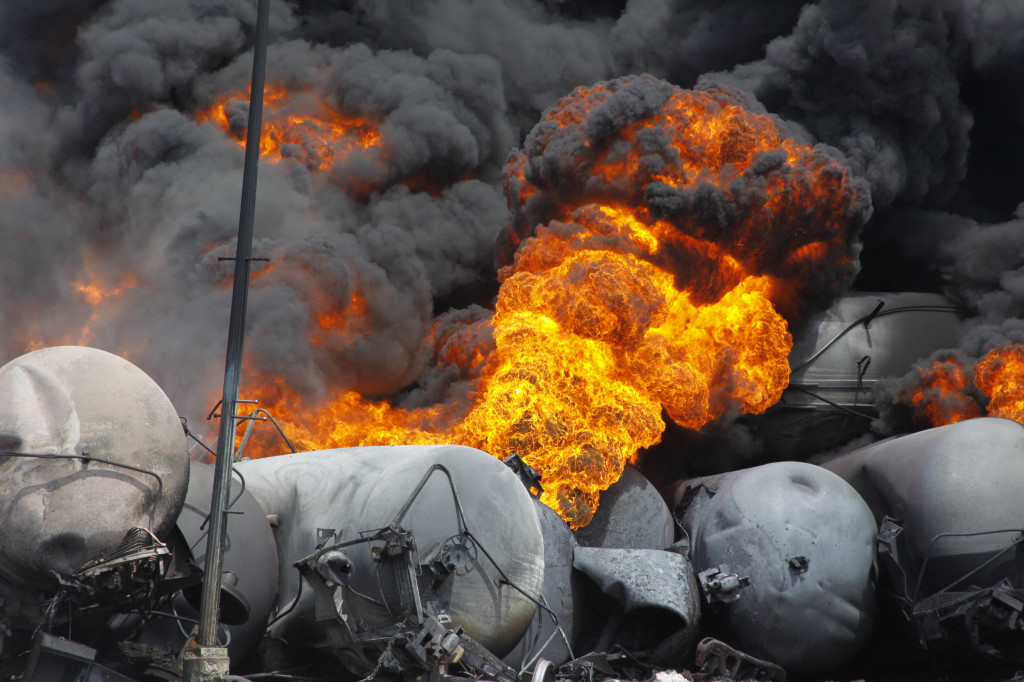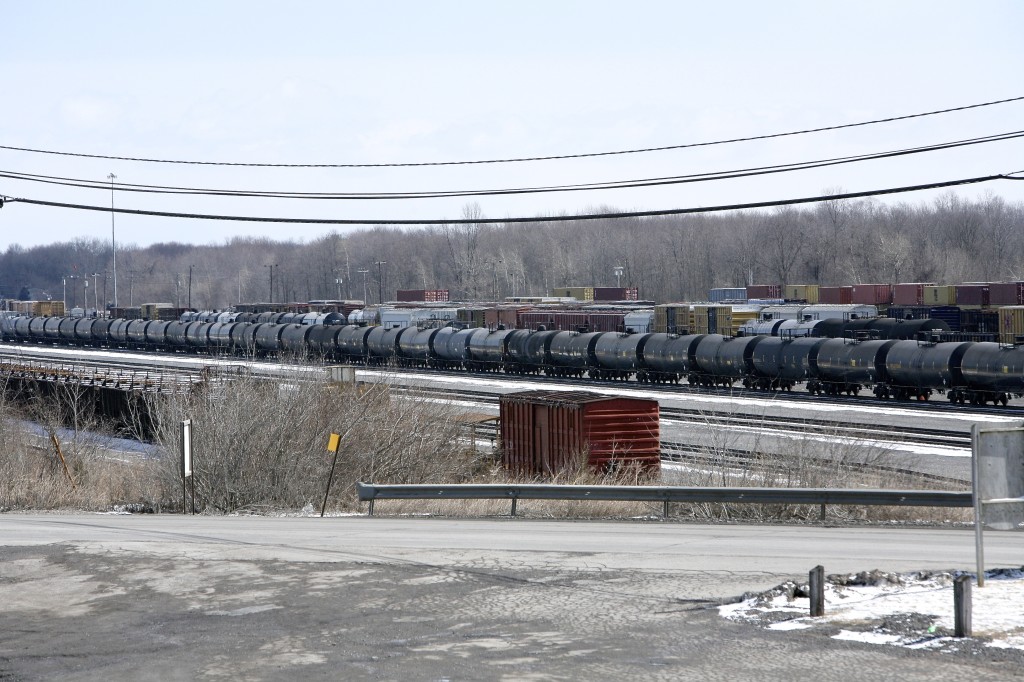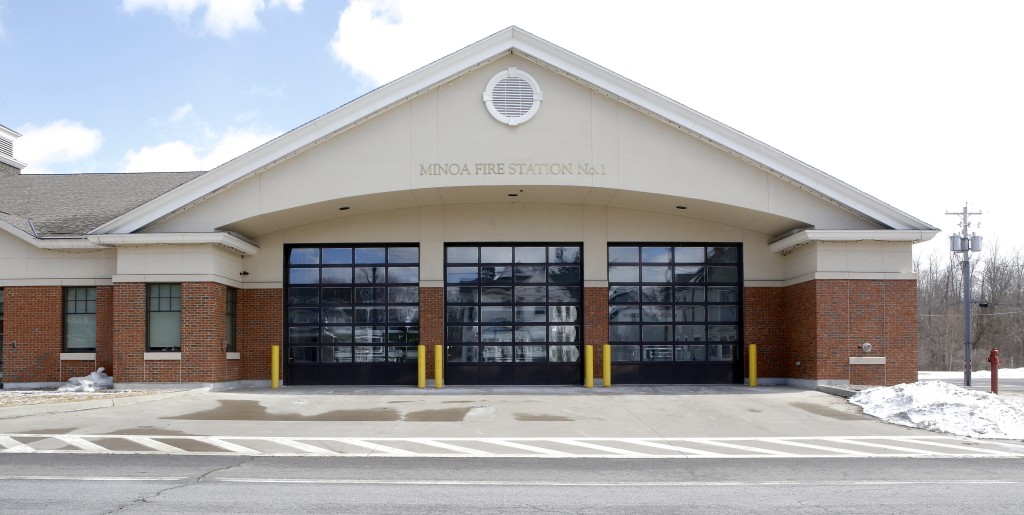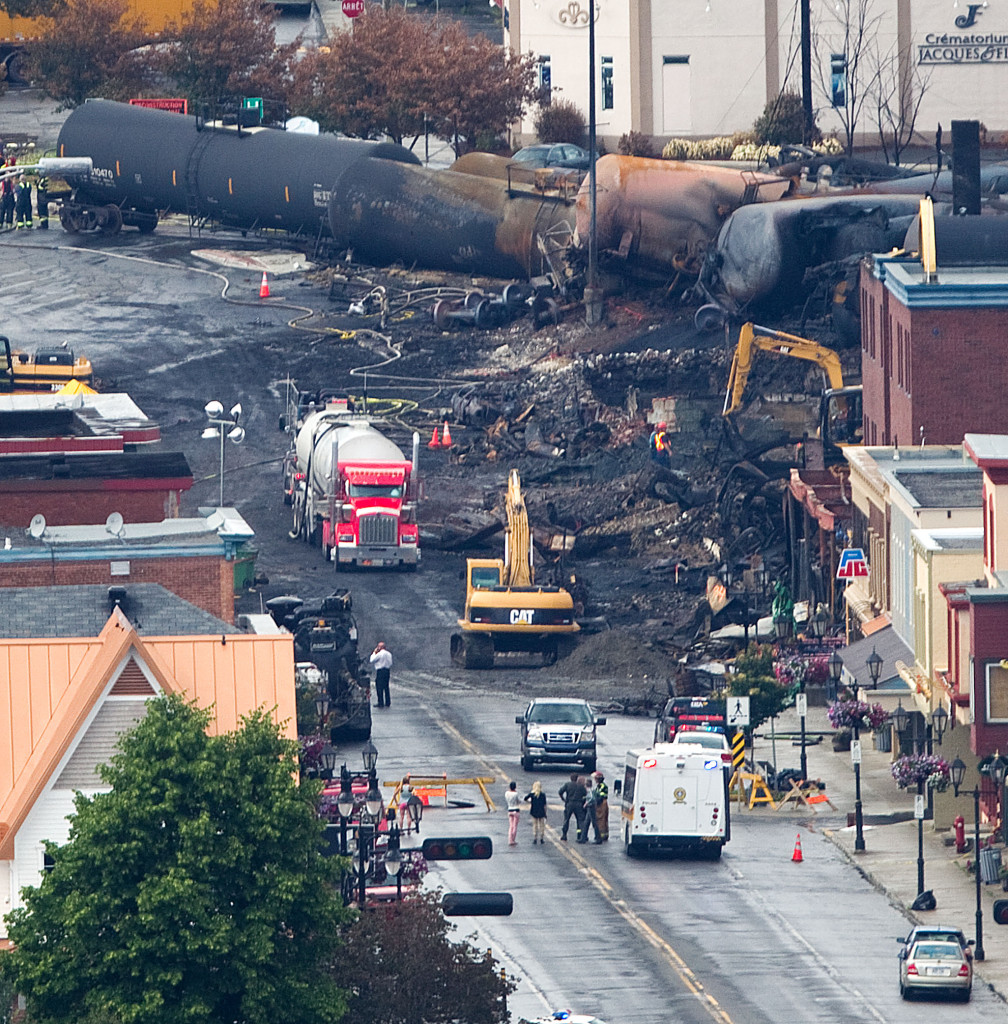(Mobile Version) Desktop users CLICK HERE
 “I would be shocked if they haven’t been trained by the rail company,” Mann said in February by telephone from his office. “They can get training and information. The railroad will provide it.”
It has not.
On Feb. 17, an employee answering the phone at the County Emergency Management office was unaware that oil trains were passing through the county. Months after the first reports of volatile crude oil traveling through upstate New York, CSX has yet to fully brief Onondaga County officials on the hazards of the oil.
Mark Zoanetti, deputy chief of the Syracuse Fire Department for special operations, said Feb. 26 that he was “just recently familiar” with the oil shipments.
“It’s early in the program,” Zoanetti said. “I spoke with {County Emergency Management Commissioner} Kevin Wisely to find out if it is coming through Central New York and how much. There is no pre-planning as to this product. That will be in the near future. My understanding is that Wisely has reached out to CSX. . . there is not a lot of information thus far.”
“We don’t know definitively, but we are pretty sure {it passes through Syracuse},” Zoanetti said.
It was not until March 18 that the county held its first meeting with the Syracuse Fire Department and with Oswego County officials dealing with the issue. Zoanetti said there were “no big changes” as a result of that meeting.
“We’re going to work the plan that we have. If it’s not on fire when we get there, we treat it the same as any other spill,” he said.
But other communities have learned with tragic consequences that Bakken Shale oil catches fire and explodes more than other types of crude.
“I would be shocked if they haven’t been trained by the rail company,” Mann said in February by telephone from his office. “They can get training and information. The railroad will provide it.”
It has not.
On Feb. 17, an employee answering the phone at the County Emergency Management office was unaware that oil trains were passing through the county. Months after the first reports of volatile crude oil traveling through upstate New York, CSX has yet to fully brief Onondaga County officials on the hazards of the oil.
Mark Zoanetti, deputy chief of the Syracuse Fire Department for special operations, said Feb. 26 that he was “just recently familiar” with the oil shipments.
“It’s early in the program,” Zoanetti said. “I spoke with {County Emergency Management Commissioner} Kevin Wisely to find out if it is coming through Central New York and how much. There is no pre-planning as to this product. That will be in the near future. My understanding is that Wisely has reached out to CSX. . . there is not a lot of information thus far.”
“We don’t know definitively, but we are pretty sure {it passes through Syracuse},” Zoanetti said.
It was not until March 18 that the county held its first meeting with the Syracuse Fire Department and with Oswego County officials dealing with the issue. Zoanetti said there were “no big changes” as a result of that meeting.
“We’re going to work the plan that we have. If it’s not on fire when we get there, we treat it the same as any other spill,” he said.
But other communities have learned with tragic consequences that Bakken Shale oil catches fire and explodes more than other types of crude.
 Cuomo’s executive order refers to it as “inherently more volatile than traditional crude.” Sen. Charles Schumer (D-N.Y.), in a news conference in Syracuse after the Lac Megantic disaster, called it a “ticking time bomb.” The federal government stepped up testing and classification requirements for Bakken crude in February, calling the shipments “an imminent hazard to public health, safety, and the environment.”
The Wall Street Journal describes Bakken crude as “a mixture of oil, ethane, propane and other gaseous liquids. . . commingled far more than in conventional crude.” According to one analyst quoted in the Journal, “You can put it in your gas tank and run it.”
Last month, the Journal published a report analyzing the volatility of types of oil that concluded the North Dakota oil was nearly three times as likely to ignite than other types of oil. The Journal compared the Reid Vapor Pressure (RVP) of Bakken oil with that of other oils. RVP is a widely used measurement of how quickly a liquid fuel evaporates and emits gases. The Journal’s analysis of North Dakota oil pegged its RVP at 8.56, compared to 3.33 for Louisiana Light Sweet oil. (Cabinda oil from Angola was the least volatile at 2.66.)
The people of Lac Megantic, a tourist village of 6,000 near the Canadian border with Maine, don’t need an algorithm to convince them that Bakken Shale oil is volatile. After midnight on July 6, 2013, a train with 74 cars of Bakken oil slipped its brakes and rolled into the town. When the train skipped the tracks, five cars exploded, and a river of flaming oil flooded the village, creating a fireball visible from space and setting half the downtown area ablaze. Forty-seven people died in the fire.
Reports of that catastrophe, in a village the size of Solvay, read like a modern Dante’s inferno. One radio report told of townspeople trying to outrun a “tsunami of fire.” Tens of thousands of barrels of oil leaked or burned, and the flaming oil poured into storm sewers, came out manholes and forced its way into the basements of homes. It took days before rescuers could enter the downtown area and recover the bodies of the dead. The tragedy at Lac Megantic was voted the News Story of the Year by the Canadian Press.
Mann, the railroad safety expert, traveled to Lac Megantic to investigate the disaster. “What happened in Canada was a bit unusual,” he said. “The underlying accident could have been prevented if adequate brakes had been applied {when the train was left parked unattended overnight}. There was only one crew member on the train, and he didn’t properly secure the train. There was an incline, and it rolled, and the result was a catastrophe.”
Cuomo’s executive order refers to it as “inherently more volatile than traditional crude.” Sen. Charles Schumer (D-N.Y.), in a news conference in Syracuse after the Lac Megantic disaster, called it a “ticking time bomb.” The federal government stepped up testing and classification requirements for Bakken crude in February, calling the shipments “an imminent hazard to public health, safety, and the environment.”
The Wall Street Journal describes Bakken crude as “a mixture of oil, ethane, propane and other gaseous liquids. . . commingled far more than in conventional crude.” According to one analyst quoted in the Journal, “You can put it in your gas tank and run it.”
Last month, the Journal published a report analyzing the volatility of types of oil that concluded the North Dakota oil was nearly three times as likely to ignite than other types of oil. The Journal compared the Reid Vapor Pressure (RVP) of Bakken oil with that of other oils. RVP is a widely used measurement of how quickly a liquid fuel evaporates and emits gases. The Journal’s analysis of North Dakota oil pegged its RVP at 8.56, compared to 3.33 for Louisiana Light Sweet oil. (Cabinda oil from Angola was the least volatile at 2.66.)
The people of Lac Megantic, a tourist village of 6,000 near the Canadian border with Maine, don’t need an algorithm to convince them that Bakken Shale oil is volatile. After midnight on July 6, 2013, a train with 74 cars of Bakken oil slipped its brakes and rolled into the town. When the train skipped the tracks, five cars exploded, and a river of flaming oil flooded the village, creating a fireball visible from space and setting half the downtown area ablaze. Forty-seven people died in the fire.
Reports of that catastrophe, in a village the size of Solvay, read like a modern Dante’s inferno. One radio report told of townspeople trying to outrun a “tsunami of fire.” Tens of thousands of barrels of oil leaked or burned, and the flaming oil poured into storm sewers, came out manholes and forced its way into the basements of homes. It took days before rescuers could enter the downtown area and recover the bodies of the dead. The tragedy at Lac Megantic was voted the News Story of the Year by the Canadian Press.
Mann, the railroad safety expert, traveled to Lac Megantic to investigate the disaster. “What happened in Canada was a bit unusual,” he said. “The underlying accident could have been prevented if adequate brakes had been applied {when the train was left parked unattended overnight}. There was only one crew member on the train, and he didn’t properly secure the train. There was an incline, and it rolled, and the result was a catastrophe.”
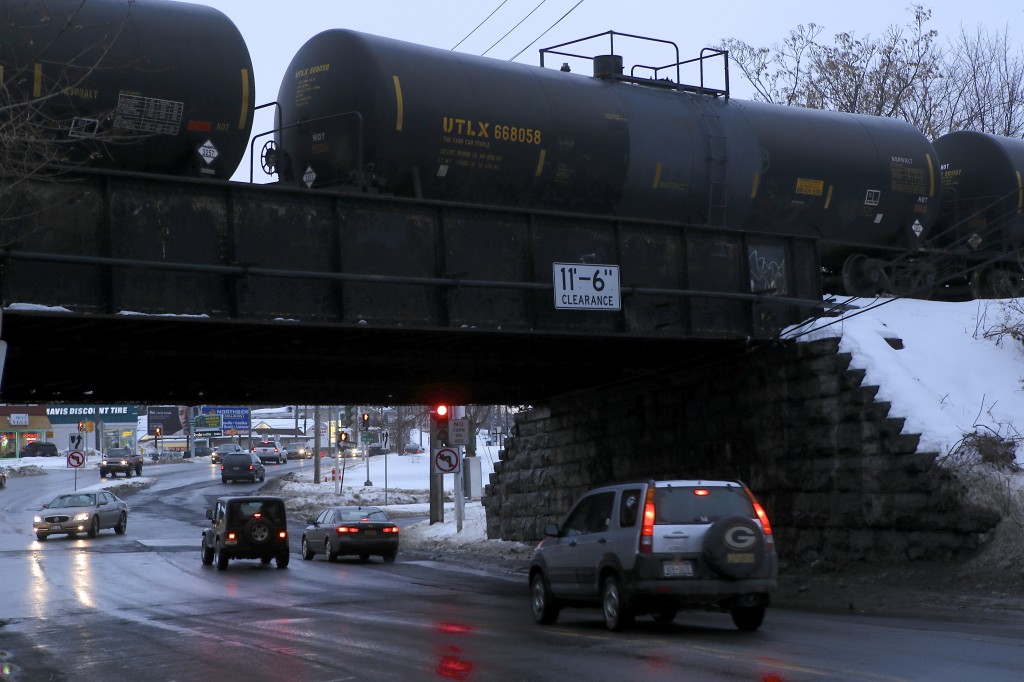 Single-person train crews do not operate along the Buffalo-Albany corridor, but railroad union officials have for years warned that they are coming. Technology and cost-cutting measures have reduced crews from five persons a generation ago to three in the 1980s to two in the 1990s.
Mann says the main danger comes not from the nature of Bakken oil but because it is being carried in unsafe train cars. “They are transporting this crude in cars designed for inert crude oil,” he said. “Instead, they need to use cars more suited to liquified natural gas.”
He said the federal agency charged with railroad and pipeline safety, the Pipeline and Hazardous Materials Safety Administration, will soon promulgate regulations to mandate improved safety features on cars transporting volatile oil. The typical cars in use, known as DOT Type 111 tankers, would have to be retrofitted with shelf plates and reinforced shells, among other features, or be replaced.
“The rail industry is on board to buy better-equipped cars,” Mann said.
The Burlington Northern Santa Fe, the largest shipper of Bakken crude, has ordered 5,000 upgraded DOT Type 111 cars. The American Association of Railroads, a private industry group, has urged its member companies to adopt the more stringent standards.
CSX, through a spokesperson, endorsed this call. In a statement sent via email by Robert Sullivan of CSX, the railroad said that “CSX supports strengthened tank car standards, as well as the {U.S. Department of Transportation’s} heightened vigilance and attention to the proper labeling of oil moving in tank cars.”
The problem, says Mann, is that replacing a fleet of 270,000 Type 111 rail cars will take up to 10 years under the best of circumstances. And until 100 percent of the cars are safe, no shipment is safe.
“If you have a 100-car train and five are defective, you’re still going to have a catastrophe,” Mann said.
Meanwhile, the railroad association released a statement Feb. 21 committing the railroads to safety measures including increased inspections, slower speeds in urban areas, improved braking and monitoring and greater assistance with emergency planning, all for areas traversed by oil trains carrying more than 20 cars of crude, which would presumably include Syracuse.
The association also pledged $5 million to develop curriculum for handling crude oil disasters such as leaks and fires. It estimates it will be able to train 1,500 first responders nationwide by the end of this year.
Single-person train crews do not operate along the Buffalo-Albany corridor, but railroad union officials have for years warned that they are coming. Technology and cost-cutting measures have reduced crews from five persons a generation ago to three in the 1980s to two in the 1990s.
Mann says the main danger comes not from the nature of Bakken oil but because it is being carried in unsafe train cars. “They are transporting this crude in cars designed for inert crude oil,” he said. “Instead, they need to use cars more suited to liquified natural gas.”
He said the federal agency charged with railroad and pipeline safety, the Pipeline and Hazardous Materials Safety Administration, will soon promulgate regulations to mandate improved safety features on cars transporting volatile oil. The typical cars in use, known as DOT Type 111 tankers, would have to be retrofitted with shelf plates and reinforced shells, among other features, or be replaced.
“The rail industry is on board to buy better-equipped cars,” Mann said.
The Burlington Northern Santa Fe, the largest shipper of Bakken crude, has ordered 5,000 upgraded DOT Type 111 cars. The American Association of Railroads, a private industry group, has urged its member companies to adopt the more stringent standards.
CSX, through a spokesperson, endorsed this call. In a statement sent via email by Robert Sullivan of CSX, the railroad said that “CSX supports strengthened tank car standards, as well as the {U.S. Department of Transportation’s} heightened vigilance and attention to the proper labeling of oil moving in tank cars.”
The problem, says Mann, is that replacing a fleet of 270,000 Type 111 rail cars will take up to 10 years under the best of circumstances. And until 100 percent of the cars are safe, no shipment is safe.
“If you have a 100-car train and five are defective, you’re still going to have a catastrophe,” Mann said.
Meanwhile, the railroad association released a statement Feb. 21 committing the railroads to safety measures including increased inspections, slower speeds in urban areas, improved braking and monitoring and greater assistance with emergency planning, all for areas traversed by oil trains carrying more than 20 cars of crude, which would presumably include Syracuse.
The association also pledged $5 million to develop curriculum for handling crude oil disasters such as leaks and fires. It estimates it will be able to train 1,500 first responders nationwide by the end of this year.
 Ed Griffin-Nolan is a journalist who believes we have to ask the hard questions no matter whose interests are at stake.
Ed Griffin-Nolan is a journalist who believes we have to ask the hard questions no matter whose interests are at stake.
Is Syracuse Ready for this Crude Oil?
When you think of crude oil, you might think Texas, or Louisiana. You probably don’t think North Dakota, and you certainly don’t think Syracuse. But a vast new find in North Dakota’s Bakken Shale oil fields has begun to produce so much oil that the nation’s pipelines cannot get it to refineries fast enough. The surplus oil makes its way to coastal refineries on railroad cars that experts call unsafe. The main trunk line from North Dakota runs through the Midwest and past Syracuse to Albany, where the oil is moved onto barges for the trip down the Hudson River. Every two and a half hours, a train of 100 cars leaves North Dakota laden with crude oil, and it is a variety that safety experts fear is too volatile for the cars that haul it. Since a fire and explosion in July destroyed part of Lac Megantic, Quebec, Canada, and killed 47 people, rail safety experts have called for changes in how this oil is transported. On Jan. 28, Gov. Andrew Cuomo directed three state agencies to come up with plans for stricter oversight of oil shipments. “New York state is taking swift and decisive action to ensure its readiness for potential disasters,” Cuomo wrote. Yet Onondaga County has yet to take any steps toward achieving that readiness. The Syracuse deputy fire chief responsible for hazardous materials says that the county is still trying to get information from the railroads and has done no training specific to the derailment of a shale oil train. The county official responsible for emergency management has ignored repeated requests for information about the shipments or about plans for dealing with accidents. In DeWitt, long freight trains move slowly in and out of the rail yard, a hub for the railway operator CSX Corp. Robert Sullivan, who speaks for the railroad, says it moves “about 14 trains with oil per week,” but CSX will not tell the public if Bakken oil goes through the DeWitt hub. Sullivan calls that commercial information, but adds that “CSX has a long history of working with emergency responders across its system and makes information about the materials handled available to those agencies on request.” Just a few hundred yards from the eastern end of the yard, four firefighters shoot the breeze at Minoa’s Fire Station No. 1 on a chilly early spring evening. None of the volunteer firefighters had heard anything about shale oil coming through, much less been trained for an accident involving the oil. “CSX is pretty tight-lipped,” said the senior man in the room, who did not wish to give his name. “They don’t tell us anything.” “If anything happens in the yard,” he said, “we’re the ones who get called. Usually it’s just a boxcar fire, or a spill of some kind.” The older firefighters can recall a hazardous materials training class perhaps six years ago; the younger ones say they haven’t had any such training. At the fire station closest to the CSX yard, no one has had training in how to handle a shale oil explosion or fire. Larry Mann literally wrote the book on railroad safety. He was the principal drafter of the Railroad Safety Act of 1970. Mann, an attorney in Washington, D.C., works for the railroad workers union, testifies before Congress regularly and has spent a lifetime advising carriers on rail safety issues. Mann believes that local emergency responders should already have been trained in how to deal with Bakken Shale oil. “I would be shocked if they haven’t been trained by the rail company,” Mann said in February by telephone from his office. “They can get training and information. The railroad will provide it.”
It has not.
On Feb. 17, an employee answering the phone at the County Emergency Management office was unaware that oil trains were passing through the county. Months after the first reports of volatile crude oil traveling through upstate New York, CSX has yet to fully brief Onondaga County officials on the hazards of the oil.
Mark Zoanetti, deputy chief of the Syracuse Fire Department for special operations, said Feb. 26 that he was “just recently familiar” with the oil shipments.
“It’s early in the program,” Zoanetti said. “I spoke with {County Emergency Management Commissioner} Kevin Wisely to find out if it is coming through Central New York and how much. There is no pre-planning as to this product. That will be in the near future. My understanding is that Wisely has reached out to CSX. . . there is not a lot of information thus far.”
“We don’t know definitively, but we are pretty sure {it passes through Syracuse},” Zoanetti said.
It was not until March 18 that the county held its first meeting with the Syracuse Fire Department and with Oswego County officials dealing with the issue. Zoanetti said there were “no big changes” as a result of that meeting.
“We’re going to work the plan that we have. If it’s not on fire when we get there, we treat it the same as any other spill,” he said.
But other communities have learned with tragic consequences that Bakken Shale oil catches fire and explodes more than other types of crude.
“I would be shocked if they haven’t been trained by the rail company,” Mann said in February by telephone from his office. “They can get training and information. The railroad will provide it.”
It has not.
On Feb. 17, an employee answering the phone at the County Emergency Management office was unaware that oil trains were passing through the county. Months after the first reports of volatile crude oil traveling through upstate New York, CSX has yet to fully brief Onondaga County officials on the hazards of the oil.
Mark Zoanetti, deputy chief of the Syracuse Fire Department for special operations, said Feb. 26 that he was “just recently familiar” with the oil shipments.
“It’s early in the program,” Zoanetti said. “I spoke with {County Emergency Management Commissioner} Kevin Wisely to find out if it is coming through Central New York and how much. There is no pre-planning as to this product. That will be in the near future. My understanding is that Wisely has reached out to CSX. . . there is not a lot of information thus far.”
“We don’t know definitively, but we are pretty sure {it passes through Syracuse},” Zoanetti said.
It was not until March 18 that the county held its first meeting with the Syracuse Fire Department and with Oswego County officials dealing with the issue. Zoanetti said there were “no big changes” as a result of that meeting.
“We’re going to work the plan that we have. If it’s not on fire when we get there, we treat it the same as any other spill,” he said.
But other communities have learned with tragic consequences that Bakken Shale oil catches fire and explodes more than other types of crude.
Why?

Sen. Charles Schumer (D-N.Y.) and Syracuse Mayor Stephanie Miner (right) held a news conference last summer calling for improved safety measures for trains carrying Bakken Shale crude oil. (Photo: Sen. Schumer website)
Could it happen here?

Tank cars similar to these, on a bridge over West Genesee St. carry the Bakken Shale oil east to Albany. The trains with the shale oil are often a hundred cars long, and they include only the oil cars. (Michael Davis photos)
Absent a pipeline, rail is the only alternative
The Bakken oil passing through Central New York is just one element in an extensive shift in the production and distribution of petroleum products that is taking place nationally and globally with lightning speed. Since the wide-scale deployment of high-volume horizontal hydrofracking in the past decade, the United States has moved from a position of worried consumer of other nations’ oil and gas toward being a net exporter. The recent crisis on the Crimean peninsula illustrated the possibilities of the United States to use its power in world energy markets to influence global events. Each new development in the energy sector—hydrofracking gas in the Marcellus Shale, building the Keystone XL pipeline to move Canadian tar sands oil, shipping Bakken oil by rail—renews the debate on climate change, renewable energy sources and the safety of transporting petroleum products over long distances. Most of the attention has been focused on the proposed Keystone XL pipeline, which would transport tar sands oil from Alberta, Canada, to the U.S. Gulf Coast for refining and export. Meanwhile, says Travis Proulx, of Environmental Advocates of NY, “the oil industry is trying to turn our rail infrastructure into their global export facility.” Whether or not Keystone XL is approved, he suggests, the oil industry is “trying to set up infrastructure to transport Canadian tar sands oil through New York state.” His organization has gone beyond calls for greater rail safety and would like to see a moratorium on all oil shipments through the state. Ironically, it is the absence of a pipeline from North Dakota to the East Coast that has caused the dramatic increase in rail shipments of oil over the past five years. Oil companies prefer pipelines over railroads, which can cost as much as three times per unit shipped. Don Siegel, the chair of the Department of Earth Sciences and Geology at Syracuse University, argues that pipelines not only cost less, but are much safer. “Since there is no pipeline,” writes Siegel in an email, “we are now moving volatile oil from the Bakken by train. If the oil moved in a pipeline, there would be minimal risk of explosion because leaks don’t explode, they just spill oil on the ground. The other risks with oil spills from pipelines are local and can be cleaned up quickly enough—as they have been in the past. A pipeline leak with modern technology will be detected quickly and stopped, and then the oil is scooped up and the groundwater, if contaminated, cleaned up in a relatively short time frame. The angst over the Keystone pipeline is scientifically unfounded, if certainly provocative.” However the Bakken oil moves east, its destination is Albany. A Massachusetts company, Global Partners LP, has petitioned to build an oil processing facility at the Port of Albany that would prep the crude for transfer to the barges that carry the oil down the Hudson and ultimately to refineries in New Jersey, Delaware and New Brunswick. Last year, the company signed an agreement with Phillips 66 to provide 91 million barrels to Phillips 66’s refinery in Bayway, N.J., all of it to be shipped through Albany. That contract alone would mean that 50,000 barrels per day of Bakken crude will pass through Albany, and the only way it can get there is by rail. Global Partners refers to the rail shipment as a “virtual pipeline.” Global’s expansion in Albany has raised alarms among New York environmentalists. Albany County Executive Dan McCoy recently issued an executive order imposing a moratorium on he company’s plans for the oil processing facility, and the state’s Department of Environmental Conservation extended the period for public comment on the project until June 2. McCoy’s order, which might not be legally binding, is the kind of action Proulx and other environmental activists say more local officials need to take. Proulx contends that all levels of government have their role to play. “We need bold leadership. Fracked oil cannot be transported safely,” Proulx says. “It’s far more dangerous from a public safety and environmental perspective. If there was a shipping accident along the Hudson, it would be an unparalleled disaster.” “We’re pushing the government to see who has the power to do that. County executives should work with their legal teams to see what they can do,” Proulx says. Ed Griffin-Nolan is a journalist who believes we have to ask the hard questions no matter whose interests are at stake.
Ed Griffin-Nolan is a journalist who believes we have to ask the hard questions no matter whose interests are at stake.





